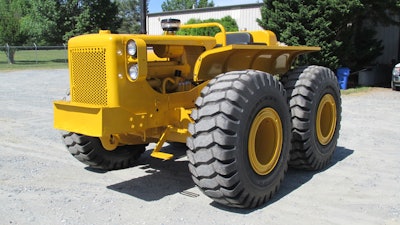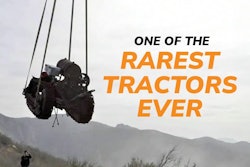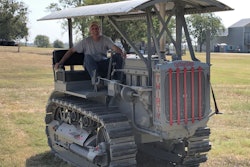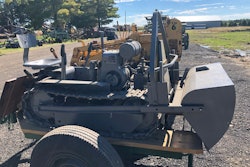
As an avid Caterpillar collector, Erik Christenbury had the “Sugar Baby” Cat on his wish list.
He had heard about the D6s that got their nickname after U.S. Sugar had converted them from tracks to rubber tires in the 1950s and 1960s. The company used those “DW6s” for hauling wagons filled with 30 tons of sugar cane from the fields to the company’s sugar mills.
When one of the converted D6s popped up on eBay, Christenbury thought he’d finally scored. Another bidder, however, captured the prize.
In 2011, he got a second chance.
A friend who owns a scrapyard in southwest Virginia called to say one just showed up and asked if he were interested. He drove from his home in Liberty, North Carolina, to have a look.
“I didn't realize he had two of them,” Christenbury recalls. “And before our conversation ended, I bought both of them.”
The transaction yielded a 1957 DW6 9U and a 1962 DW6 B.
(To watch a video of the 1962 “Sugar Baby” DW6 B in action, check out the video at the end of this story.)
Made for Sugar
 A postcard from the Clewiston Motor Company, now Kelly Caterpillar, in Florida. Clewiston converted the D6s into "Sugar Babies" for U.S. Sugar to haul cane from the fields to the mills in the 1950s and 1960s.Erik Christenbury
A postcard from the Clewiston Motor Company, now Kelly Caterpillar, in Florida. Clewiston converted the D6s into "Sugar Babies" for U.S. Sugar to haul cane from the fields to the mills in the 1950s and 1960s.Erik Christenbury
The converted DW6s were better for hauling the cane-filled wagon trains over road than the crawler versions. Uses for the converted tractors also expanded beyond the Southern U.S. cane fields, with some owners adding dozer blades or winches. Barnum & Bailey Circus used them for pulling circus wagons on and off railcars.
Wheeled Caterpillars were not exactly a new creation. The company had produced DW10s and DW6s in the 1940s but with smaller front wheels. The so-called “Sugar Babies” were specially created for sugar production, with all four wheels the same size. It’s estimated about 150 of them were made for U.S. Sugar.
Restoration
 Erik Christenbury's "Sugar Baby" before restoration.Erik Christenbury
Erik Christenbury's "Sugar Baby" before restoration.Erik Christenbury
He soon found out after stripping the 1962 model down in his shop.
“I saw something in the back of the transmission,” he recalls. “It was white, looked like a loaf of bread. It was a chunk of ice.
“So I realized that was the one that had the transmission problem.”
The restoration took about three months and involved rebuilding and replacing “basically everything from the engine flywheel back,” he says. He also cleaned it up, painted it and put on new tires.
Not Just a "Big Skid Steer"
 Erik Christenbury
Erik Christenbury
“Some people recognize it as a Sugar Baby,” he says. “A lot of people think it's just a big skid steer.”
“It’s neat because it’s big,” he adds. “It’s oversized – loud. Kids like things with big tires, too.”
The wheeled D6 runs similarly to its original crawler version, Christenbury says.
“It operates just like a conventional track-type tractor. You just have a lot of friction on concrete when you go to turning; you basically just have to slide the tires around.”
“How fast does it go?” he’s asked.
“Faster than you want to drive it,” he says and laughs. “I'm not sure how fast it goes. It's got a pretty tall gear. I've never had it in high gear going down a road.”
Christenbury still has the 1957 DW6 9U but hasn’t had a chance to start working on it yet
“We're going to restore it one day,” he says. “That day just hadn’t come around yet.”
So for now, he’s still taking the 1962 DW6 B Sugar Baby to nearby tractor shows and parades. The agricultural festival organizers appreciate that the old D6 has tires instead of tracks because it doesn’t tear up the grass or asphalt. And he enjoys operating it. The crowds love it, too.
“It always brings a lot of smiles to people's faces.”
To watch the 1962 “Sugar Baby” DW6 in action, check out the video below, with footage provided by his sons’ SE Films Productions:











